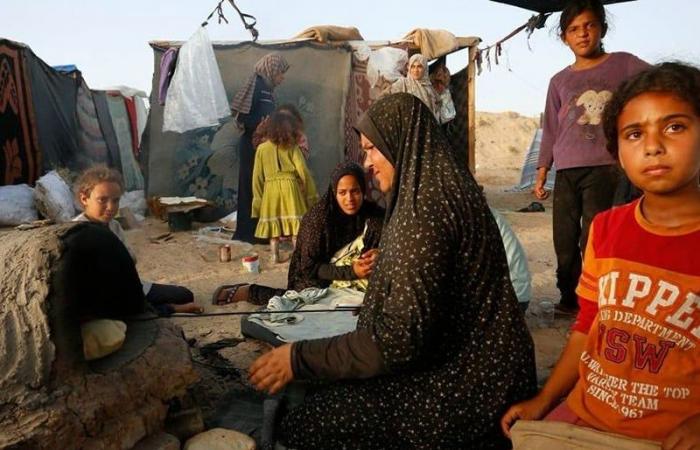Nearly half a million people remain hungry at “catastrophic” levels in the Gaza Strip, which remains at risk of famine despite slight improvement in the north of the besieged territory, the United Nations humanitarian agencies.
According to the Integrated Food Security Classification Framework (IPC) document, a high risk of famine persists across the Gaza Strip as long as the conflict continues and humanitarian access is restricted.
UN humanitarian agencies therefore warn that full and sustainable humanitarian access remains essential to reverse the situation and prevent famine.
But if access to humanitarian aid made it possible to avoid the famine feared in the last assessment published in March, the report nevertheless underlines that the entire Gaza Strip, or 96% of the population (2.15 million people), face extreme levels of hunger.
“Negative and very unstable” trajectory
While the entire territory is classified as an emergency situation, more than 495,000 people (22% of the population) still face catastrophic levels of acute food insecurity (IPC Phase 5). This means that one in five Palestinians in the enclave suffer from the highest level of malnutrition, or more than one in five households go entire days without eating.
In this phase, households face extreme lack of food, hunger and exhaustion of survival skills.
Furthermore, 745,000 people (33%) are classified in an emergency situation (IPC phase 4).
“Humanitarian space in the Gaza Strip continues to shrink and the capacity to safely deliver aid to populations is dwindling. The recent trajectory is negative and very unstable,” the UN update says.
Slight improvement compared to March
“The new report notes a slight improvement over the previous assessment in March, which warned of a potential famine in Gaza’s northern governorates by the end of May,” commented the World Food Program (WFP) in a press release.
And to emphasize that “This improvement shows the difference that better access can make. “Increased food deliveries to the north and nutrition services have helped reduce the most severe levels of hunger, leaving the situation still desperate.”
The latest IPC report published in mid-March estimated that more than 1.1 million Gazans were facing “a catastrophic hunger situation”close to starvation, “the highest number ever recorded” by the UN.
Furthermore, the latest assessment shows that in the North Gaza governorates, the entire population will likely remain fully exposed and highly vulnerable to conflict and insecurity. Consequently, humanitarian aid is expected to remain close to the levels seen in March and April.
The challenge of access for humanitarian aid
In the governorates of Deir al-Balah, Khan Younis and Rafah, at least one of the border crossings is expected to remain open, although agencies face security and administrative constraints in delivering aid. Military operations in Rafah and parts of Deir al-Balah and Khan Younis will likely result in additional displacement towards the “humanitarian zone” designated by Israel.
But the World Food Program is seriously concerned that the severely reduced capacity of humanitarian organizations to deliver essential aid in the south is putting progress made at risk. The WFP now fears that southern Gaza could soon experience the same catastrophic levels of hunger seen in northern areas.
To reverse the trend and prevent famine, adequate and sustainable humanitarian aid must be provided, warns WFP
These include greater availability of fresh food and better nutritional diversity, clean water and sanitation, access to health care and the reconstruction of clinics and hospitals. “A broad and multisectoral response is urgently needed,” insists the UN agency based in Rome.
Lost trace of thousands of children screened in Rafah
Echoing this situation in Gaza, Yasmina Guerda, head of humanitarian affairs at the United Nations Office for the Coordination of Aid (OCHA), returned with “stories that will haunt her for the rest of [sa] very privileged life »after three months spent in the enclave during two deployments.
Freshly returned from Gaza, the humanitarian worker described a worrying situation. This is the case in Rafah where massive displacements since the start of the Israeli offensive on May 7 have prevented residents from accessing malnutrition screening centers. Consequently, there is “thousands of children who were followed or screened and of whom we suddenly lost track”, she declared.
Generally speaking, the dramatically insufficient access of aid in the enclave, where the delivery of humanitarian aid remains ” a puzzle “ because of “ongoing fighting, a void in terms of public order and security” as well as “regular attacks” against aid storage facilities, administrative difficulties and hours of waiting at checkpoints, only compounds the horror of the situation.
The lack of fuel is hampering not only the delivery of aid, but also protection efforts, including the ability of humanitarians to reach unaccompanied children on the move, warned Yasmina Guerda.
Life in Gaza “hangs by a thread”
Describing the water and sanitation crisis in the Gaza Strip, Guerda spoke of the harrowing experiences of families she saw “digging makeshift septic tanks with spoons, using toilets and pipes from destroyed buildings in order to have some privacy and hygiene near their tents.”
After three months in the enclave during two deployments, Yasmina Guerda said she was stunned.
“We really shouldn’t talk about the living conditions in the Gaza Strip, because no people in Gaza have living conditions,” she told reporters in Geneva. “What they have, if you look closely, is survival conditions. And barely. They are hanging by a thread.” did she say.
The humanitarian worker gave journalists an insight into the daily reality of a population that has “lost almost everything” in the context of massive forced displacement and where “no centimeter” is not safe in Gaza.






